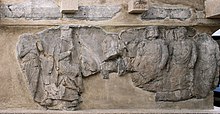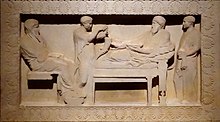Satrap
A satrap (/ˈsætrəp/) was a governor of the provinces of the ancient Median and Persian (Achaemenid) Empires and in several of their successors, such as in the Sasanian Empire and the Hellenistic empires.[2] A satrapy is the territory governed by a satrap.[3]
A satrap served as a viceroy to the king, though with considerable autonomy. The word came to suggest tyranny or ostentatious splendour,[4][5] and its modern usage is a pejorative and refers to any subordinate or local ruler, usually with unfavourable connotations of corruption.[6]
Etymology
The word
In the
In
meaning "keeper").History
Medo-Persian

Although the first large-scale use of satrapies, or provinces, originates from the inception of the Achaemenid Empire under Cyrus the Great, beginning at around 530 BCE, provincial organization actually originated during the Median era from at least 648 BCE.
Up to the time of the conquest of
The satrap was in charge of the land that he owned as an administrator, and found himself surrounded by an all-but-royal court; he collected the taxes, controlled the local officials and the subject tribes and cities, and was the supreme judge of the province before whose "chair" (Nehemiah 3:7) every civil and criminal case could be brought. He was responsible for the safety of the roads (cf. Xenophon), and had to put down brigands and rebels.
He was assisted by a council of Persians, to which also provincials were admitted and which was controlled by a royal secretary and emissaries of the king, especially the "eye of the king", who made an annual inspection and exercised permanent control.
There were further checks on the power of each satrap: besides his secretarial scribe, his chief financial official (Old Persian ganzabara) and the general in charge of the regular army of his province and of the fortresses were independent of him and periodically reported directly to the shah, in person. The satrap was allowed to have troops in his own service.
The great satrapies (provinces) were often divided into smaller districts, the governors of which were also called satraps and (by Greco-Roman authors) also called hyparchs (actually Hyparkhos in Greek, 'vice-regents').[14] The distribution of the great satrapies was changed repeatedly, and often two of them were given to the same man.

As the provinces were the result of consecutive conquests (the homeland had a special status, exempt from provincial tribute), both primary and sub-satrapies were often defined by former states and/or ethno-religious identity. One of the keys to the Achaemenid success was their open attitude to the culture and religion of the conquered people, so the Persian culture was the one most affected as the Great King endeavoured to meld elements from all his subjects into a new imperial style, especially at his capital, Persepolis.

Whenever central authority in the empire weakened, the satrap often enjoyed practical independence, especially as it became customary to appoint him also as general-in-chief of the army district, contrary to the original rule. "When his office became hereditary, the threat to the central authority could not be ignored" (Olmstead). Rebellions of satraps became frequent from the middle of the 5th century BCE.
The last great rebellions were put down by Artaxerxes III.
Seleucid

The satrapic administration and title were retained—even for Greco-Macedonian incumbents—by Alexander the Great, who conquered the Achaemenid Empire, and by his successors, the Diadochi (and their dynasties) who carved it up, especially in the Seleucid Empire, where the satrap generally was designated as strategos (in other words, military generals); but their provinces were much smaller than under the Persians. They would ultimately be replaced by conquering empires, especially the Parthians.
Parthian and Sassanian
In the
Indian
The Western Satraps or Kshatrapas (35–405 CE) of the
See also
References
- JSTOR 42668124.
- ^ "Satrap". Free Merriam-Webster Dictionary. Merriam-Webster. Retrieved 26 January 2012.
- ^ "satrapy". Wiktionary.org. Retrieved 14 August 2020.
- ^ "satrap". Oxford English Dictionary.
- ISBN 978-0-19-162041-6. Retrieved 28 November 2020.
- ISBN 978-0-19-966135-0.
- ^ "Greece xii. Persian Loanwords and Names in Greek". Encyclopædia Iranica. 2012. Archived from the original on 25 February 2024. Retrieved 25 February 2024.
- ^ Bukharin, Mikhail. "[Towards the Discussion on the Language of the Scythians: The Transition of OIr *xš- > *s- and its Reflection in the Ancient Greek] К дискуссии о языке скифов: переход др.ир. *xš- > *s- и его отражение в древнегреческом". Проблемы Истории, Филологии, Культуры. 2013. 2. В честь 60-летия В.Д. Кузнецова. С. 263–285.
- ^ "Kshatrapa, Kṣatrapa, Kshatra-pa: 8 definitions". Wisdom Library.
- ^ Esther 3:12 The Bible (Jewish Publication Society, 1917)
- ^ 'ăḥašdarpᵊnîm (H323) in Strong's Concordance
- ^ MacKenzie, David Neil (1971). "šasab". A Concise Pahlavi Dictionary.
- ISBN 978-0-520-24731-4.
- ^ Tuplin, Christopher, "The Administration of the Achaemenid Empire". In I. Carradice (ed.), Coinage and Administration in the Athenian and Persian Empires (1987; Oxford: BAR), 109-166.
- ^ Mørkholm, Otto (1991). Early Hellenistic Coinage: From the Accession of Alexander to the Peace of Apamea. Cambridge University Press. p. 73f.
- ^ Curtis, John; Tallis, Nigel; André-Salvini, Béatrice (2005). Forgotten Empire: The World of Ancient Persia. pp. 258–59, fig. 454, Silver tetradrachm of Bagadates.
Further reading
- Ashley, James R. (2004) [First published 1998]. "Appendix H: Kings and Satraps". The Macedonian Empire: The Era of Warfare Under Philip II and Alexander the Great, 359–323 B.C. Jefferson, NC: McFarland. pp. 385–391. ISBN 978-0-7864-1918-0.
- A. T. Olmstead, History of the Persian Empire, 1948.
- Pauly-Wissowa (comprehensive encyclopaedia on Antiquity; in German).
- Robert Dick Wilson. The Book of Daniel: A Discussion of the Historical Questions, 1917. Available on home.earthlink.net.
- Rüdiger Schmitt, "Der Titel 'Satrap'", in Studies Palmer ed. Meid (1976), 373–390.
- This article incorporates text from a publication now in the public domain: Chisholm, Hugh, ed. (1911). "Satrap". Encyclopædia Britannica (11th ed.). Cambridge University Press..
- Cormac McCarthy, All the Pretty Horses, 1992.


